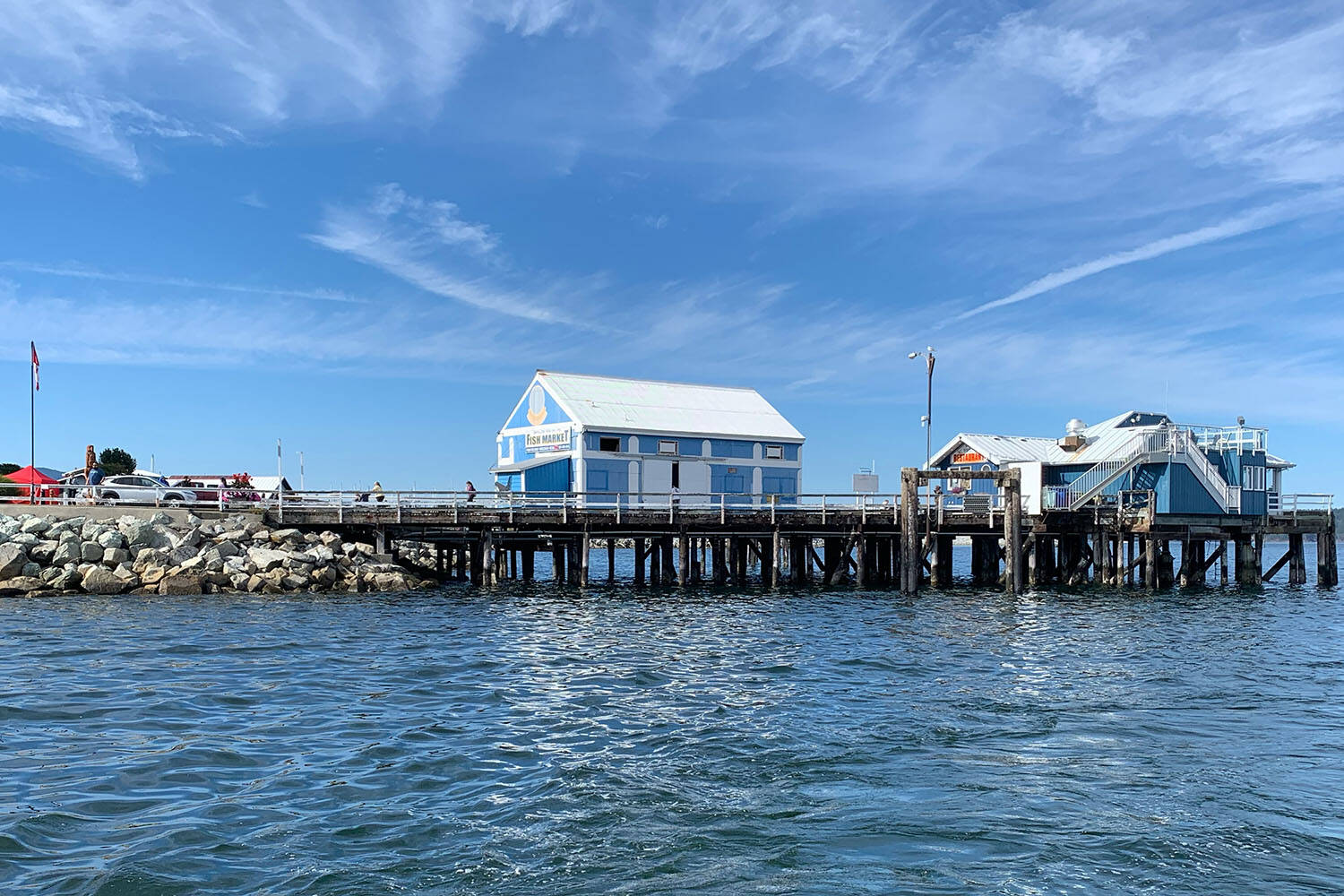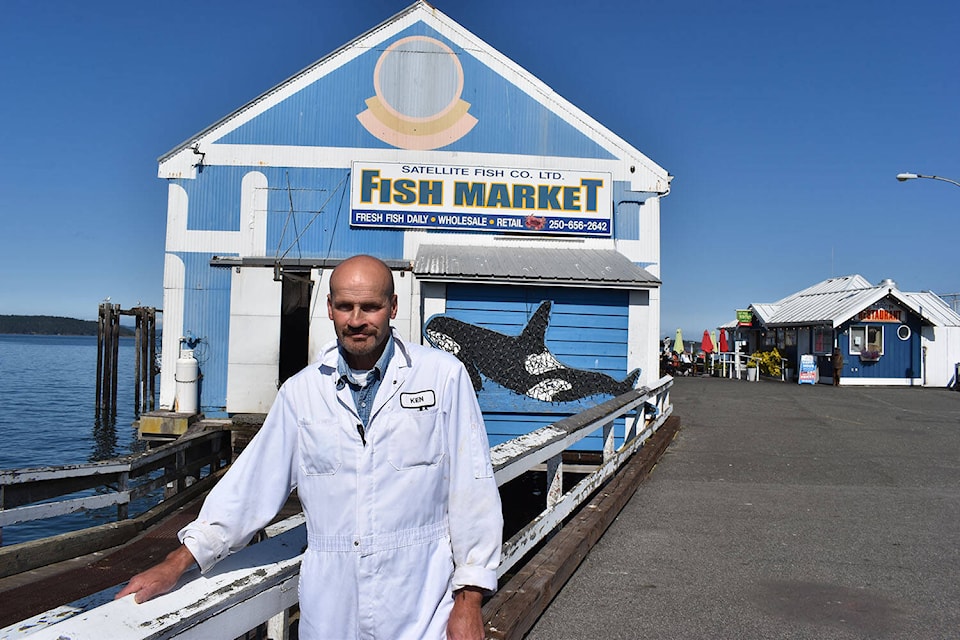Two entrepreneurs operating on Sidney’s Beacon Wharf say the community stands to lose an iconic part of its heritage without a change in strategy from the Town of Sidney.
Ken Norbury owns Satellite Fish Company market in the iconic blue building, while Donna May operates the nearby Pier Bistro. Both question why the municipality is presenting only two official options: removal of the structure with no replacement, or its replacement by a pontoon once part of a floating bridge in Washington State.
Information released by the town describes the latter option as a public-private partnership with Sidney Waterfront Partnership (SWP). The company would transform the pontoon into a floating wharf, which would have a two-storey building featuring a restaurant and two commercial spaces (one reserved for the municipality) on the main floor and eight hotel units above.
“What do the locals want?” said May, questioning the choices. “We don’t just want a small handful of wealthy people deciding for the whole future of Sidney. So I’m really hoping that the town will make sure it does go through a very open public process and I’m hoping they can come together with more than just this one option.”
RELATED: Sidney won’t add third option to Beacon Wharf engagement process
She and Norbury suggest a lack of creativity from the select committee reviewing the options. They also questioned the suitability of the roughly 60-year-old pontoon, although it has been given a clean bill of health by third-party consultants. Still, Norbury asked why the town would replace one old structure with another. The business owners also lamented what they call a lack of consultation by the municipality concerning their operations’ specific fates.
Randy Humble, Sidney’s chief administrative officer, told Black Press Media in August that town staff have discussed the wharf’s future with the tenants and informed them of the work of the select committee. All its meetings were open to the public, Humble added, noting that agendas, minutes and meeting videos are available on the municipality’s website.
Municipal officials have promised an open process. Coun. Peter Wainwright, one of three council members sitting on the select committee, said council will hear from the public regardless if they do not like either option.
A special Beacon Wharf-related edition of the municipal newsletter Town Talk was released online Sept. 9 and sent out by mail. It allows residents to write in another option with the appeal to “please specify another viable idea that you’d like the Town to consider.”
The municipality also scheduled two engagement sessions, Tuesday, Sept. 21 (3 to 5 p.m.) and Wednesday, Sept. 29 (11 a.m to 2 p.m.) at Beacon Park and is accepting feedback through its regular channels. The deadline for submissions is Oct. 15.
May acknowledged that the public will get a chance to voice other options, but said, “people don’t think that way. When they are coming down and looking at it, they are just going to go, ‘yes or no.’ So why can’t there be a couple more options?”
The newsletter includes replacement options rejected by the committee before it settled on the two official options. Broadly speaking, the committee rejected piled and rubble-mound options for reasons of costs in the face of climate change, for visual impact and return on investment. Humble did note that the alternatives not recommended would still be available for consideration through community engagement.
RELATED: Public to weigh in on future of Sidney wharf
Among arguments against maintaining the existing wharf, the newsletter states the 100-year-old structure would need a major refurbishment within the next seven to eight years. Since the town took it over from the federal government in 2006 it has had two condition assessments and two rounds of repairs. “It is at the point where a major investment will be required to extend its life beyond 2028.”
In the newsletter the town estimated that a more significant rehabilitation would cost millions, and made an economic case in favour of the Sidney Waterfront Partnership proposal.
The town indicated that other floating structure options are available, but noted that the reduced-cost SWP option may not be available later. Creating a floating wharf from scratch would come with a much higher cost, it adds. As well, it states a wharf without buildings greatly reduces its value and makes it unlikely a request for proposals for a stand-alone commercial component would receive any submissions.
An estimate done before Sidney received the SWP proposal pegged the cost of a new floating wharf at about $10.61 million, which is greater than the SWP proposal. Either way, Sidney does not have funds set aside for replacing the wharf and would have to borrow funds to do so.
The anticipated $5 million loan related to the SWP proposal would come with an estimated cost per household between $30 and $38 per year over a 25-year span, according to the newsletter. The increased commercial property tax revenues generated from the wharf’s commercial operations would offset borrowing costs.
But money does not appear to be only factor in determining the wharf’s future.
One petition that calls for preservation of the wharf, citing its iconic status, has drawn almost 1,000 signatures and members of the Save Our Sidney community group have been working on a number of alternatives.
Publicly available correspondence received by the municipality so far also points to considerable skepticism – if not outright opposition – to the floating wharf option.
This emotional dimension also swings through the comments of Norbury and May.
For Norbury, the fish market is part of his family history – he purchased it a decade ago from his uncle Don, who bought the business in 1964. While the Pier Bistro’s history on the wharf is shorter, it is no less part of the wharf’s iconography. May called the structure a global calling card for the municipality and fears that its disappearance will hurt the town’s image.
“I really think it is going to ruin Sidney,” she said of any plan to remove the wharf. “It takes away from the quaintness.”
But May is prepared to accept the public’s verdict. “If the locals want us gone, fine, then we are done,” she said. “But it really should go to a definite public process.”
She later struck a more defiant tone.
“Here is the deal,” she said. “I’m 55. This is my only job. I’m single. I’d be screwed if I lose this. So I am going to fight tooth and nail to stay here.”
Do you have a story tip? Email: vnc.editorial@blackpress.ca.
Follow us on Twitter and Instagram, and like us on Facebook.
wolfgang.depner@peninsulanewsreview.com

